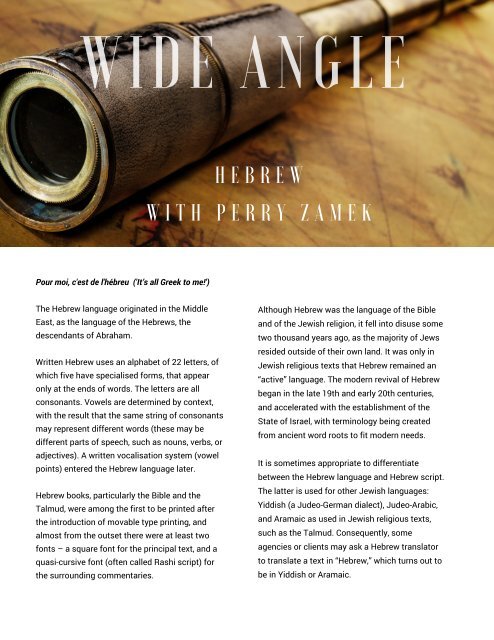CONNECTIONS No. 1
The Standing Out Mastermind magazine
The Standing Out Mastermind magazine
You also want an ePaper? Increase the reach of your titles
YUMPU automatically turns print PDFs into web optimized ePapers that Google loves.
WIDE ANGLE<br />
H E B R E W<br />
W I T H P E R R Y Z A M E K<br />
Pour moi, c'est de l'hébreu ('It’s all Greek to me!')<br />
The Hebrew language originated in the Middle<br />
East, as the language of the Hebrews, the<br />
descendants of Abraham.<br />
Written Hebrew uses an alphabet of 22 letters, of<br />
which five have specialised forms, that appear<br />
only at the ends of words. The letters are all<br />
consonants. Vowels are determined by context,<br />
with the result that the same string of consonants<br />
may represent different words (these may be<br />
different parts of speech, such as nouns, verbs, or<br />
adjectives). A written vocalisation system (vowel<br />
points) entered the Hebrew language later.<br />
Hebrew books, particularly the Bible and the<br />
Talmud, were among the first to be printed after<br />
the introduction of movable type printing, and<br />
almost from the outset there were at least two<br />
fonts – a square font for the principal text, and a<br />
quasi-cursive font (often called Rashi script) for<br />
the surrounding commentaries.<br />
Although Hebrew was the language of the Bible<br />
and of the Jewish religion, it fell into disuse some<br />
two thousand years ago, as the majority of Jews<br />
resided outside of their own land. It was only in<br />
Jewish religious texts that Hebrew remained an<br />
“active” language. The modern revival of Hebrew<br />
began in the late 19th and early 20th centuries,<br />
and accelerated with the establishment of the<br />
State of Israel, with terminology being created<br />
from ancient word roots to fit modern needs.<br />
It is sometimes appropriate to differentiate<br />
between the Hebrew language and Hebrew script.<br />
The latter is used for other Jewish languages:<br />
Yiddish (a Judeo-German dialect), Judeo-Arabic,<br />
and Aramaic as used in Jewish religious texts,<br />
such as the Talmud. Consequently, some<br />
agencies or clients may ask a Hebrew translator<br />
to translate a text in “Hebrew,” which turns out to<br />
be in Yiddish or Aramaic.



